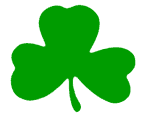For millions of people today, the shamrock is the emblem of Ireland. The shamrock seems to have acquired its emblematic symbolism at the same time as it became associated with Saint Patrick, in the late seventeenth and early eighteenth centuries.
The association between Saint Patrick and the shamrock grew during years of widespread suppression of Irish Catholics and the confiscation of their lands. The first time that the shamrock was put into the hand of Saint Patrick who offers it to assembled people, was on a coin issued by the Confederate Catholics of Kilkenny in 1645. The first mention of shamrock as a badge is found in the 1681 diary of Thomas Dinely, who travelled throughout Ireland during King Charles II's reign: "The 17th day of March yearly is Saint Patrick's, an immoveable feast when ye Irish of all stations and conditions wear crosses in their hats, some of pins, some of green ribbon, and the vulgar superstitiuosly wear shamroges. 3 leaved grass which they likewise eat to cause a sweet breath". Dinely associated the wearing of shamrock with the lower social classes. Those who wore the shamrock were the same peasants whose behaviour at pilgrimages caused concern to bishops throughout the seventeenth and eighteenth centuries. When Jonathan Swift observed Irish men and women in London on St Patrick's Day, 1713, he noted that they wore crosses. There is no mention of shamrocks becuase the Irish he saw in London were wealthy, city dwellers who visited the fashionable West End of London. Today shamrock is cultivated in Ireland and exported in time for 17 March to USA and Europe to be worn by the Irish and the honorary Irish, who take on the nationality for a few hours. Back to Saint Patrick's Mission
[ Armagh | Downpatrick | Slane | Ardagh | Saul | Croagh Patrick | Lough Derg ] |
 The Confederates were Royalists who wanted to barter their loyalty for freedom to practise Catholicism and ensure the return of their confiscated land.
The Confederates were Royalists who wanted to barter their loyalty for freedom to practise Catholicism and ensure the return of their confiscated land.